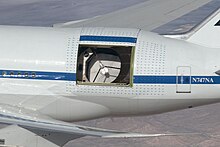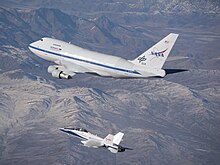Airborne astronomy
As Airborne Observatory (Engl. Airborne astronomy) are astronomical projects refer to operations where telescopes and other instruments in aircraft are installed and operated at high altitudes as observation platforms.



History and projects
Jules Janssen first used a balloon for astronomical research in 1874. Research balloons and airplanes have been used to conduct astronomical observation missions since the 1920s . Various types of aircraft have been used including a. a Felixstowe F5L flying boat . For modern airborne programs were u. a. Learjet 24 , Lockheed C-141 , McDonnell Douglas F / A-18 and Boeing 747 adapted.
Some programs, such as B. the Lear Jet Observatory (LJO, in two versions) and the Kuiper Airborne Observatory (KAO) were successfully completed. A current program is the Stratospheric Observatory For Infrared Astronomy (SOFIA), in which an infrared telescope was integrated into a Boeing 747 SP . Observation flights at altitudes of typically 12-14 km are carried out with it.
Projects that used balloon-borne telescopes were e.g. B. Stratoscope (1957, 1971), BOOMERanG (1998, 2003), Sunrise (2009, 2013), Far Infrared Interferometric Telescope (announced).
NASA and NSF (National Science Foundation) (USA) have been cooperating since 1989. Every year 1–2 balloons with different measuring devices, including astronomical ones, are launched. Great heights of up to around 40 km were achieved and - especially in the polar vortex over the South Pole - a flight duration of around 2 months. Christopher Walker won a NASA competition with his LBR (Large Balloon Reflector) concept of using a partially metallized balloon in a giant balloon as an optical reflector, and has continued to develop it since 2014.
technology
Significantly higher starting altitudes are accessible for observations based on the air than on the ground, which means that turbidity caused by aerosol (dust, water droplets) and animals (flying insects, bats, birds), fluctuations in refraction in unstable layers of air and absorption of infrared by water vapor and scattering by the air molecules can be avoided much further . Supported by the earth, the height is limited by the accessibility of the mountain for transport vehicles (construction, energy supply, people) and oxygen partial pressure that is still acceptable for people.
The carrying capacity of aircraft limits the weight and thus the size and opening of the telescopes that can be flown. Aircraft can be relocated globally in order to observe the northern and southern skies and can use the winter half-years alternating in the course of the year - with long, dark nights - in the northern and southern hemisphere. By inserting it in different widths, for example by flying along meridional routes, it is possible to observe with smaller zenith angles and thus reduce the thickness of the air layer to be penetrated. When a telescope looks out of the open window on the circumference of the cylindrical fuselage, as is the norm today, the air pressure here in the aircraft is only around 15% of normal pressure at 13 km above sea level. The area in the fuselage in which the operating personnel of the telescope is located requires around 70% normal pressure (cabin height) to be sealed off from the telescope space in a pressure-tight manner. The pilot cockpit and operator's cabin can be sealed off from one another in large aircraft, but are located next to each other, which means that the telescope is regularly mounted further back in the aircraft, but still sufficiently far in front of a vertical stabilizer. Airplane windows for telescopes are usually made lockable like earth-based observatory domes so that no rain and no animals can penetrate when flying through the weather zone troposphere and on the ground. If this closure, as with SOFIA, consists of a relatively thin sheet in grooves, it will not be able to close airtight and pressure-tight, so that the fuselage cannot be stiffened by slightly increased internal pressure in the cell. A large window opening weakens the fuselage statically, so that a stiffening frame has to be installed around the window. In the direction of flight and air flow in front of a window opening, transverse, inclined strips can repel air flow, rain and foreign bodies such as birds from the window opening.
When SOFIA was stationed in Christchurch, New Zealand in June / July 2015 (as in 2013 and 2016) in the southern winter, the ground crew used facilities at the airport that were provided by the US National Science Foundation (NSF) for their Antarctic in the summer. Research program can be used.
See also
literature
- Wendy Whiting Dole: Milestones in Airborne Astronomy - From the 1920's to the Present. NASA Ames Research Center, 1997, pdf online
- Michael R. Haas: Airborne Astronomy Symposium on the Galactic Ecosystem - From Gas to Stars to Dust. Astronomical Soc. of the Pacific, San Francisco 1995, ISBN 0-937707-92-9 .
- Daniel D. Durdaa, et al .: SWUIS-A - A Versatile, Low-Cost UV / VIS / IR Imaging System for Airborne Astronomy and Aeronomy Research. pdf online
- Barb Mulkin: In Flight - The Story of Los Alamos Eclipse Missions. Los Alamos Science, pdf online
- Larry M. Stepp, et al .: Ground-based and Airborne Telescopes III. SPIE Volume 7733, 2010, ISBN 978-0-8194-8223-5 , abstracts
Web links
- SOFIA - The Future of Airborne Astronomy adsabs.harvard.edu
- SOFIA science center Educational Materials
- SWUIS-A Airborne Occultation Demonstration Project Southwest Research Institute Planetary Science Directorate
- airborne @ Seti Institute seti.org
Individual evidence
- ^ John K. Davies Astronomy from Space - the design and operation of orbiting observatories. Wiley, New York 1997, ISBN 0471962589 , pp. 4-13
- ↑ Wendy Whiting Dole: Milestones in Airborne Astronomy - From the 1920's to the Present. Retrieved February 24, 2020 . sofia.usra.edu (pdf; 3.1 MB)
- ↑ Innovative Airborne Astronomy Capability Now Operational. boulder.swri.edu
- ↑ DRYDEN F-18s FLY AIRBORNE ASTRONOMY OCCULTATION EXPERIMENT. NASA Dryden News Releases, February 23, 2000 (accessed June 15, 2010); F-18 Airborne Astronomy. dfrc.nasa.gov
- ↑ airborne @ seti institute
- ↑ LEAR JET OBSERVATORY AND KUIPER AIRBORNE OBSERVATORY PUBLICATIONS. ( Memento from June 9, 2010 in the Internet Archive ) sofia.usra.edu (Retrieved June 18, 2010)
- ↑ Ames Research Center: A Complete Service Center for Airborne Earth Observation. ( Memento of October 23, 2011 in the Internet Archive ) gsfc.nasa.gov, accessed on August 14, 2011
- ↑ DLR webcast: SOFIA - The flying infrared observatory. dlr.de, May 26, 2010
- ↑ First Light- First observation flight from SOFIA. dlr.de, May 28, 2010 (accessed June 14, 2010)
- ^ NASA's Scientific Ballooning Program 2009, accessed October 6, 2016.
- ↑ Ballooning Expectations: New Approach for Astronomy NASA, May 3, 2016, accessed October 6, 2016. - English.
- ↑ SOFIA starts science flights in New Zealand dlr.de,> Missions> SOFIA, June 19, 2015, accessed October 6, 2016.

